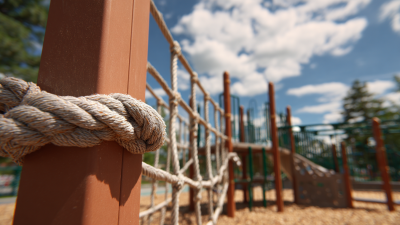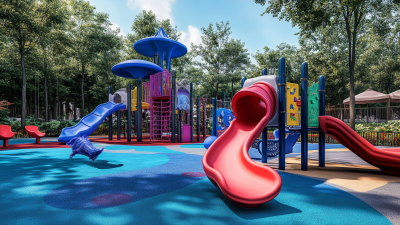
Inquiry
Form loading...
The exploration of child development and safety in recreational environments has led to an increasing focus on the use of Soft Playground Equipment. As children engage in play, they not only entertain themselves but also develop crucial physical, social, and emotional skills. Dr. Emily Carter, a renowned expert in pediatric play safety, emphasizes that “Soft Playground Equipment is essential in creating a safe environment where children can explore and learn without the fear of injury.” This highlights the dual benefits of these innovative installations: promoting active play while minimizing risks.

Soft Playground Equipment transforms traditional playgrounds into vibrant, secure spaces. By incorporating materials that are designed to absorb impact, these play structures allow children to engage in more vigorous activities without the typical hazards associated with hard surfaces. This safety aspect is particularly vital as it encourages parents to let their children play freely, fostering independence and confidence.
Moreover, the versatility of Soft Playground Equipment supports various developmental milestones. Whether it’s climbing, balancing, or imaginative play, these safe environments stimulate creativity and social interaction, laying a foundation for holistic child development. As we delve into the benefits of such equipment, it becomes clear that investing in these playgrounds not only prioritizes child safety but also enriches the overall play experience.
Soft playground equipment plays a crucial role in enhancing the physical development of young children. Unlike traditional playground structures, which can pose risks of injury, soft equipment provides a safer environment for active play. This safety encourages children to explore their physical capabilities, from climbing and jumping to rolling and balancing. As they engage in these activities, they improve their gross motor skills, coordination, and overall physical fitness, laying a strong foundation for a healthy lifestyle.
In addition to promoting physical development, soft playground equipment fosters confidence and social skills. By allowing children to take risks in a safe setting, they learn to navigate challenges and overcome fears. Playing alongside peers on soft structures encourages teamwork and communication, as children collaborate to create games and share experiences. This combination of physical activity and social interaction is essential for holistic development, equipping children with both the physical skills and social competencies they'll carry into later life.
Soft playground equipment plays a crucial role in fostering cognitive growth in children, providing a unique environment where learning and play intertwine seamlessly. The vibrant colors, varied textures, and interactive elements of soft play structures stimulate children's senses, encouraging them to explore and engage. As children navigate through these playful environments, they develop critical thinking and problem-solving skills by figuring out how to climb, slide, or balance. This hands-on play experience enhances their spatial awareness and boosts their confidence as they learn to overcome challenges.
Moreover, soft play equipment encourages imaginative play, which is essential for cognitive development. As children invent games or storylines, they practice communication and social skills, collaborating with peers and sharing ideas. This imaginative aspect not only fosters creativity but also helps children understand concepts such as turn-taking and empathy. By engaging with others in a safe and supportive environment, children enhance their emotional intelligence, laying a foundation for future learning experiences. Thus, the integration of soft play equipment in playground settings cannot be overstated; it is an essential tool for facilitating the holistic development of young minds.
Soft playground equipment has emerged as a crucial element in enhancing child safety during playtime. One of the primary benefits of using soft play surfaces is the significant reduction in injury risks. Traditional playgrounds often feature hard surfaces that can lead to severe injuries from falls or collisions. In contrast, soft playground equipment is designed to absorb impact, providing a cushion for children as they play. This cushioning effect is essential as it allows kids to experiment, take risks, and develop their physical skills without the looming fear of injury.
Tips for choosing the right soft play surfaces: include considering the age group of the children using the playground. Ensure the materials are age-appropriate and can withstand the activity level typical for that age. Additionally, regular maintenance of soft surfaces is crucial; check for wear and tear to ensure the safety features remain effective.
Moreover, combining soft play equipment with a variety of engaging activities can enhance both safety and enjoyment. Incorporate elements that promote balance, coordination, and imaginative play, all while keeping the children safe. By prioritizing soft surfaces for playground equipment, caregivers can create a win-win environment where children thrive physically and socially without compromising their safety.
Soft play areas serve as an essential environment for fostering social skills among children. These spaces, designed with soft playground equipment, encourage interaction through play. As children engage in cooperative games or simply share toys, they naturally develop communication and negotiation skills. This interaction helps them learn how to express themselves, understand others' perspectives, and manage conflicts—important skills that will benefit their social development in the long run.
Tips for parents: Encourage your child to invite friends to play in soft play areas. This not only enhances their social circle but also helps them practice sharing and teamwork. Be active in guiding their interactions, stepping in when necessary to facilitate conversations or resolve disputes, allowing your child to learn how to navigate social dynamics effectively.
Moreover, soft play areas can alleviate the intimidation some children feel in larger playgrounds. The inclusive nature of these spaces makes them inviting, ensuring every child feels comfortable exploring various activities. This supportive atmosphere lays the foundation for forming friendships, enhancing self-esteem, and nurturing empathy as kids learn to care for one another during play.
Tips for parents: Participate in playtime with your child, providing encouragement and praise for their social efforts. Modeling positive interactions will reinforce their learning and boost their confidence in engaging with others.
The importance of soft playground equipment in promoting long-term health benefits for children cannot be overstated. According to a report by the American Academy of Pediatrics, children who engage in active play are 30% more likely to maintain healthy weight levels into their adolescence. Soft playground surfaces significantly reduce the risk of injuries, encouraging parents to allow their children to explore and play actively. Safe environments lead to increased outdoor playtime, helping combat the growing concern of childhood obesity, which affects approximately 1 in 5 children in the United States according to the CDC.
Moreover, creating safe spaces for play has psychological and social advantages. A study published in the Journal of School Health found that children who regularly use soft play equipment develop better social skills and higher levels of physical activity. This is vital in their overall development, fostering teamwork and cooperation while allowing them to build confidence in their physical abilities. With proper investments in soft playground solutions, communities can promote healthier lifestyles among children, ensuring they grow up not only physically active but also socially engaged.
| Aspect | Benefits | Long-Term Impact |
|---|---|---|
| Physical Development | Enhances motor skills and coordination | Leads to healthier lifestyle choices |
| Social Skills | Promotes teamwork and communication | Fosters lifelong friendships and collaboration |
| Cognitive Development | Encourages problem-solving and creativity | Improves academic performance over time |
| Emotional Well-being | Boosts confidence and self-esteem | Reduces anxiety and stress in later life |
| Safety | Minimizes risk of injury during play | Encourages parents to allow more playtime |






